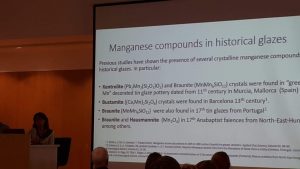The European Meeting on Ancient Ceramics (EMAC) is a biennial conference convening scholars and young researchers with diverse academic backgrounds from both the humanities and sciences. The goal of the meeting is to promote interdisciplinary and integrated studies of ancient ceramics covering various aspects ranging from production, dissemination and use to post-depositional alteration and conservation. Methodological developments, new approaches and scientific advances are presented in terms of analytical and measuring techniques, data processing and interpretation.
The 15th EMAC was organized by ARQUB, a research unit of the GRACPE research team at the Universitat de Barcelona (UB).
Judit Molera, a member of Scientific Committee of EMAC-2019, presented an oral communication about “The stability range of different manganese compounds in ancient glazes”.
Previous studies have shown the presence of several crystalline manganese compounds in historical glazes. In particular, kentrolite (Pb2Mn2(Si2O7)O2) and Braunite (MnMn6SiO12) crystals were found in “green and Mn” decorated Tin-glaze pottery dated from 11th century in Murcia, Mallorca (Spain), meanwhile Bustamite ((Ca,Mn)2Si2O6) crystals were found in Barcelona 13th century1. Braunite was also found in 17th tin glazes from Portugal2 and Braunite and Hausmannite (Mn3O4) in 17th Anabaptist faiences from North-East-Hungary3, among others.
The presence of those microcrystallites seems certainly related to the raw materials used, methods of application and firing temperatures. However, little information about how the presence of specific crystallites and the technology are known referring to the calcium content in pastes and glazes. In order to obtain information about the relationship between the presence and distribution of specific crystallites across the glaze and the methods of production, a set of replication experiments are designed to study the effect of different methods of application and firing processes. The main objective is to determine the stability range of Pyrolusite, Bixbiyte, Hausmannite, Kentrolite, Braunite and Bustamite in lead glazes to use them as a fingerprint of technology.
1 J. Molera, J. Coll, A. Labrador, T. Pradell (2013). Manganese brown decorations in 10th to 18th century Spanish tin glazed ceràmics. Applied Clay Science, Volume 82, 86-90.
2 S. Coentro, R. A. A. Trindade, J.M, António Candeias, V. S. F. Muralha (2014). Hispano-Moresque ceramic tiles from the Monastery of Santa Clara-a-Velha (Coimbra, Portugal). Journal of Archaeological Science, Volume 41, 21-28.
3 B. Bajnóczi, G. Nagy, M. Tóth, I. Ringer, A. Ridovics (2014). Archaeometric characterization of 17th-century tin-glazed Anabaptist (Hutterite) faience artefacts from North-East-Hungary. Journal of Archaeological Science, Volume 45, 1-14.





Leave a Reply